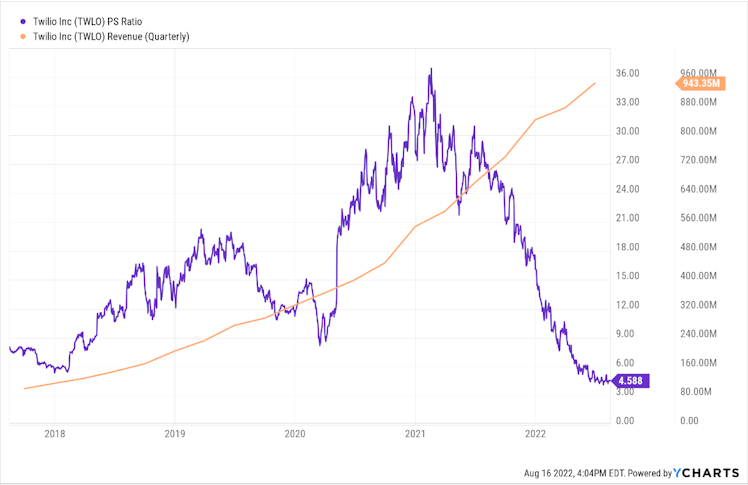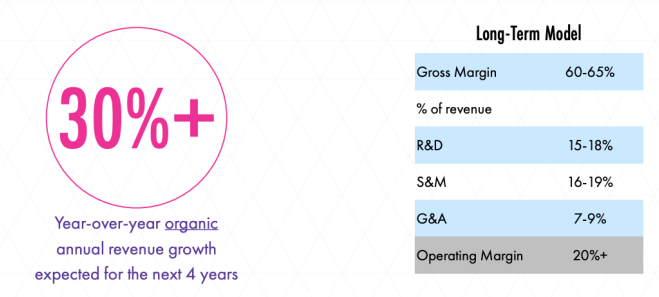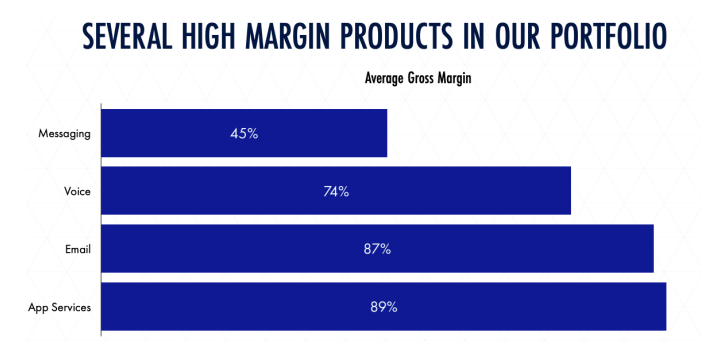Trending Assets
Top investors this month
Trending Assets
Top investors this month
Checking in on Twilio $TWLO
I like to keep tabs on stocks that I have owned previously, in the event that their execution catches back up with the potential I had identified previously. When I invest in a company, it is because I see an opportunity in which a strong product strategy could drive durable revenue growth and operating leverage over the long term. However, that thesis may not always play out as expected, or may take longer to align with execution. Companies can also experience different product adoption curves, cycling through rapid and slowing growth, as each product category achieves market fit.
Twilio (TWLO) is one such stock that I rotated in and out of, first entering in mid-2018 and exiting in 2021. During that time period, I watched the stock ascend from about $60 to an all-time-high of $443 in February 2021. Since its 2021 highs, the stock has descended back into the $80's, putting it well below the price range going back to 2019 (pre-Covid). It's Price/Sales ratio is now below 5, an all-time low over the prior 5 years. This ratio was above 10 for most of 2018-2019, reaching as high as 20 in mid-2019 and even peaked at 37 in 2021.

Yet, Twilio's quarterly revenue has continued to increase almost linearly over the last 5 years. While much of that has been from acquisitions, the company has managed to keep organic revenue growth well above 30% for most of that period. The problem has been in profitability and operating leverage. Gross margin has been stuck in the low 50% range, and has been declining quarterly (as reported) over the past year. Operating margin on a Non-GAAP basis has been consistently bouncing around break-even, even as the annualized revenue run rate approaches $4B. At that scale, investors have to wonder when Twilio will turn a profit. I think this has been the primary overhang for the stock, with the worsening gross margin outlook eroding confidence that even break-even can be maintained. Additionally, a continued large allocation to SBC keeps operating margin on a GAAP basis deeply negative.
If I revisit my thesis for owning the stock previously in 2019-2020, I had the following assumptions:
- Twilio is a leading provider in a very large addressable market, estimated by the company to reach $110B by 2023.
- Twilio could leverage their foundation in CPaaS API plumbing with strong developer engagement to move upmarket into higher-margin software applications.
- Cross-sell would reduce costs in sales and marketing, driving revenue growth and operating leverage and reflected in strong DBNER.
- With reasonable margins, Twilio could continue to invest in R&D to keep the product funnel flowing. New software applications would add to the margin profile, funding even more R&D.
- Twilio could launch new innovative product offerings in adjacent categories, precluding a need to perform acquisitions to maintain growth.
At their Investor Day in October 2020, the company painted a fairly optimistic long term plan of 30%+ annual revenue growth for several years and improving operating margins. Since then, the organic revenue growth has been achieved (although decelerating). The margin profile, on the other hand, does not exhibit progress towards the long-term model.

With that baseline, let's look at the Q2 2022 results to see how the company is tracking. Total revenue was $943M, up 41.0% y/y. This beat analyst expectations for $921M and the company's prior estimate for $912M to $922M. However, total revenue was bolstered by $37M of ZipWhip contribution (acquisition related) and $44M from fee increases due to A2P carrier charges (which Twilio passes through). Backing out these items, organic revenue growth was 33% y/y. This compares to 50% y/y organic in Q2 2021, when Twilio was the beneficiary of Covid tailwinds. After Q3, we will lapse the need for these adjustments to total revenue growth. The ZipWhip acquisition closed in mid-July 2021 and the A2P fees were introduced in Q2 2021. Assuming Twilio doesn't execute another large acquisition, we may finally get back to the state from several years ago where Twilio's revenue performance could be tracked directly.

Looking forward to Q3, they project total revenue in the range of $965M - $975M, for 30-32% annual growth. Excluding acquisition revenue, organic growth would be 29-30%. This missed analyst expectations for $979M in revenue. Twilio no longer provides full year revenue guidance. They did, however, reiterate their estimate for full year organic revenue growth above 30%. Management remains "cautiously optimistic" about the demand environment, but observed some isolated areas of recent softness. They are not yet reporting material signs of a slowdown.
International revenue was 35% in Q2, compared to 35% last quarter and 32% a year ago. International revenue is growing faster than U.S. revenue, which is pressuring gross margin as international messaging has a very low gross margin. While this revenue is growing quickly, it is less valuable revenue from a margin point of view. In Q2 2020, international revenue was only 27% of the total. The increase in international messaging usage has been the primary contributor to the decline in gross margin over the last 1-2 years.
Profitability has been an area where investors have been expecting to see improvement, particularly as peer software infrastructure companies have demonstrated the ability to incrementally improve gross margins and operating margins over time as they scale revenue. Yet, at a $4B run rate, Twilio almost seems to be going backwards. For Q2, they delivered non-GAAP gross margin of 51.0%, which was down 160 bps from Q1 and 290 bps from Q2 2021's gross margin of 53.9%. Twilio management includes a "gross margin bridge" calculation to normalize the impact of A2P fees on the gross margin erosion. Using this adjustment, non-GAAP gross margin would have been 54.3%. The problem is that these fees aren't going away, so the as reported gross margin reflects the current state. The bridge helps provide an apples-to-apples comparison with prior periods.
The challenge that this gross margin erosion creates is that that it pressures gross profit growth. While total revenue grew 41% y/y, non-GAAP gross profit only grew by 33% y/y, impacted by gross margin reductions and out-performance in 2021.
Twilio management did reiterate their long term goal to achieve non-GAAP gross margins of 60%+. This will be achieved as software products make up a greater percentage of the revenue mix. Hosted application services (SaaS) realize much higher gross margins, in the 80% range, versus 45% for all of messaging. International messaging gross margin is even lower than the overall average.

Due to the year/year drop in gross margin, Twilio swung from Non-GAAP operating income of $4.2M a year ago to an operating loss of $7.3M this quarter. This did beat their prior guidance for ($40M) to ($35M). That shift in operating margin was primarily attributable to the decrease in gross margin of 3% y/y. To their credit, S&M and R&D relative allocations on a Non-GAAP basis remained roughly the same year/year (at 25% and 18% of revenue respectively). The G&A allocation even ticked down from 10% to 9% of revenue y/y. But, the 3% decrease in gross margin caused op margin to inflect from positive 0.6% to -0.8%. On a GAAP basis, operating margin slipped from -30% to -33%, primarily due to SBC increasing by 68% y/y.
For Q3, the profitability estimates don't show improvement. Twilio management is projecting a non-GAAP operating loss of $60-$70M. This includes an estimated one-time $35M non-cash accrual for the adoption of a new "sabbatical program for tenured employees". Without this cost, non-GAAP operating loss would be $25-35M. This is down from the -$7M delivered in Q2. This estimate for Q3 resulted in an adjusted EPS target of $(0.43) - $(0.37), as compared to analyst models for $(0.11). I have to admit that in this environment, I am surprised to see a sabbatical program introduced. I assume this provides long-time employees with an extended period of paid time-off, which I interpret as a retention tactic. It also flies in the face of commentary from other large technology companies, like Google and Facebook, that are emphasizing an opposite message of higher productivity and performance expectations.
With that said, management has committed to delivering positive operating margin in 2023, so we may see a turn next year. Additionally, acquisitions have likely been inflating operating expenses over the last couple of years. At the outset of each acquisition, the two companies generally retain some overlap in staff, which is gradually reduced as they merge organizations and operations. As we have passed the one year anniversary of Twilio's last major acquisition, this absorption headwind should abate. During the Q2 earnings call, management highlighted some other cost management efforts.
"We will continue to execute against our two primary priorities - accelerating software sales and delivering on our commitment to non-GAAP operating profit starting in 2023. To this end, we're focusing our hiring efforts on areas that we believe will unlock significant value and present strong opportunities for continued growth such as Segment, Engage and Flex, and we’ve frozen the vast majority of new hires and backfills outside of these areas. And, we’re shifting more of our selling capacity to software, while looking to leverage more of our self-service capability for customers that don't need direct account coverage. We also announced our decision to become a remote-first company and made a significant reduction in our real estate footprint."
Twilio ended Q2 with 275,000 customers. This is up from 240,000 in Q2 2021. At this point, total customer count growth isn't a relevant demand indicator. The contribution from larger customers will drive revenue growth going forward. Twilio doesn't report the count/contribution from customers spending more than a threshold like $100k, providing a dollar-based net expansion rate (DBNER) to gauge the annual increase of spend from all customers. This rate dropped to 123% in Q2, from 135% a year ago. This is the lowest DBNER in the last two years. In their heyday, Twilio was consistently posting a best-in-class DBNER well over 130%. Granted, the law of large numbers is probably kicking in and a value over 120% is still considered strong. With total customer counts only increasing by 15% y/y, DBNER will need to remain over 120% to keep revenue growth on target.
One highlight from the quarter was the announcement of an eight-figure deal with a Fortune 100 retailer for Flex, representing the largest sale ever for that product. The retailer plans to "completely reimagine their customer experience with Twilio Flex", which will also include usage of Twilio's video, chat and messaging APIs. The retailer's goal is to create a single view of the customer across the organization, crossing sales, marketing and customer service. This deal provides an important signal, as it represents the future vision of Twilio's product strategy to move upmarket into higher value application services, tapping into healthier margins. Twilio needs to land more deals like this and extend them into other software products.
After the Q2 results were announced, TWLO stock dropped 13.5% the following day. Since then, it has largely flatlined and is now down another 4%, in the low $80 range. It is approaching its 52-week low and hasn't been at this level since November 2018 (excluding the short Covid dip in March 2020). Analysts were largely disappointed by the deceleration in Q2 revenue and light Q3 guidance for both revenue and operating income. While the company re-affirmed its 30% revenue growth and 2023 profitability targets, management sounded less confident and the numbers aren't providing a lot of support.

For me, I will continue watching Twilio's performance from the sidelines. I think their strategy to leverage their foundation of CPaaS products to deliver higher value software services has potential, as evidenced by the Flex win. However, it will still take some time for this product adoption curve to kick in and may never grow to the scale needed to pull gross margins up. If it doesn't, the profitability story starts to look questionable. Twilio may be forced to slow down hiring further if they want to meet their break-even target for 2023 operating margin, which would put more pressure on growth. I would like to watch this play out for a few more quarters.
At the same time, the valuation multiple is at a historic low. If the company can demonstrate improvement in the profitability measures discussed above and maintain their commitment of 30% organic revenue growth, then the valuation multiple might reset quickly into a higher range. At the very least, the multiple could remain static, allowing the share price to grow proportionally to revenue. I plan to keep an eye on their performance, looking for signals of traction on software product penetration and operating leverage.
Already have an account?